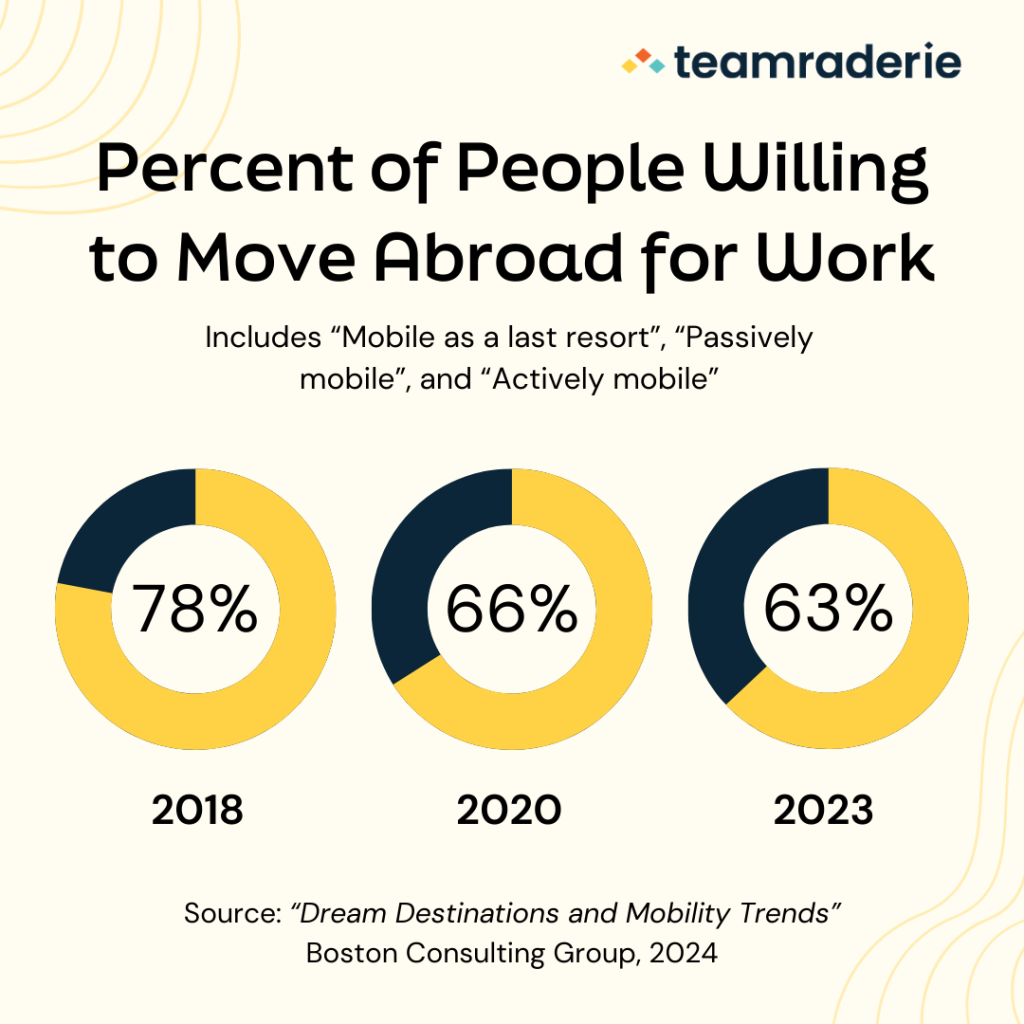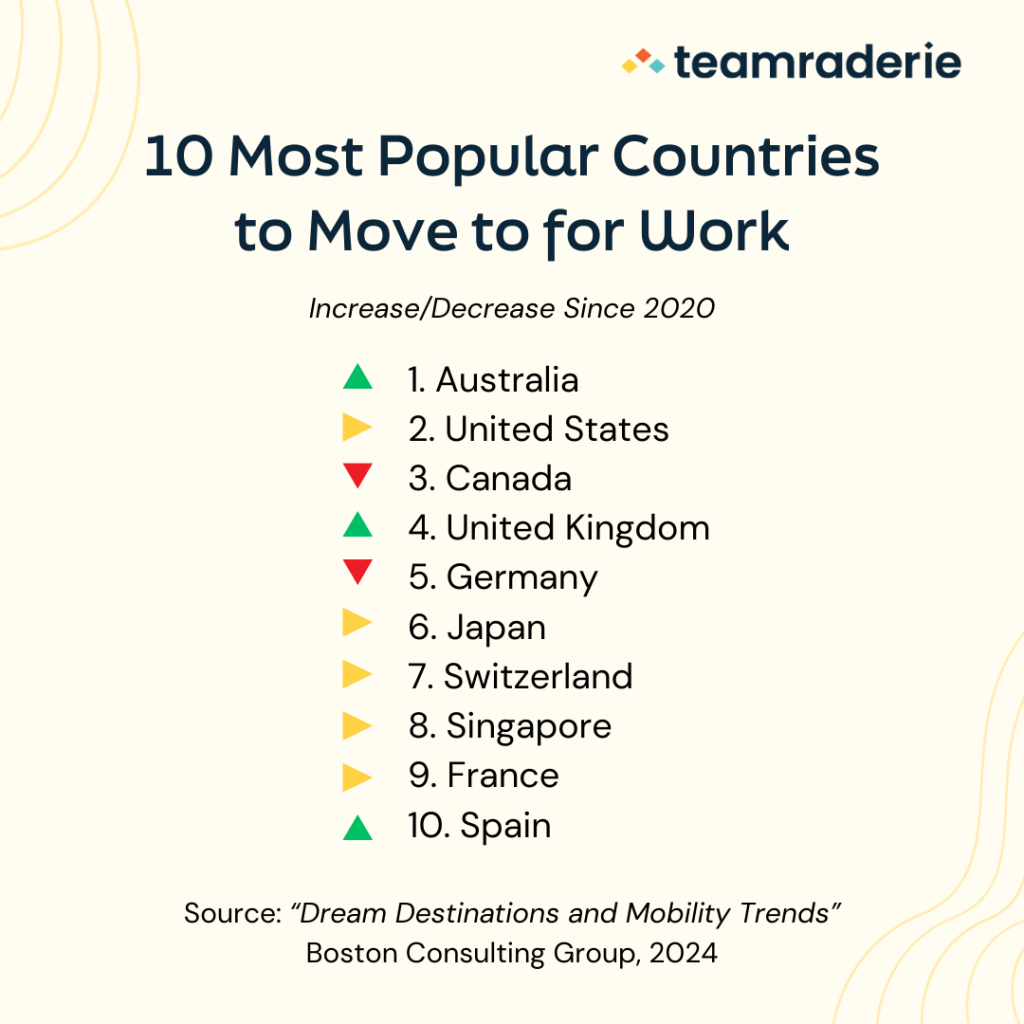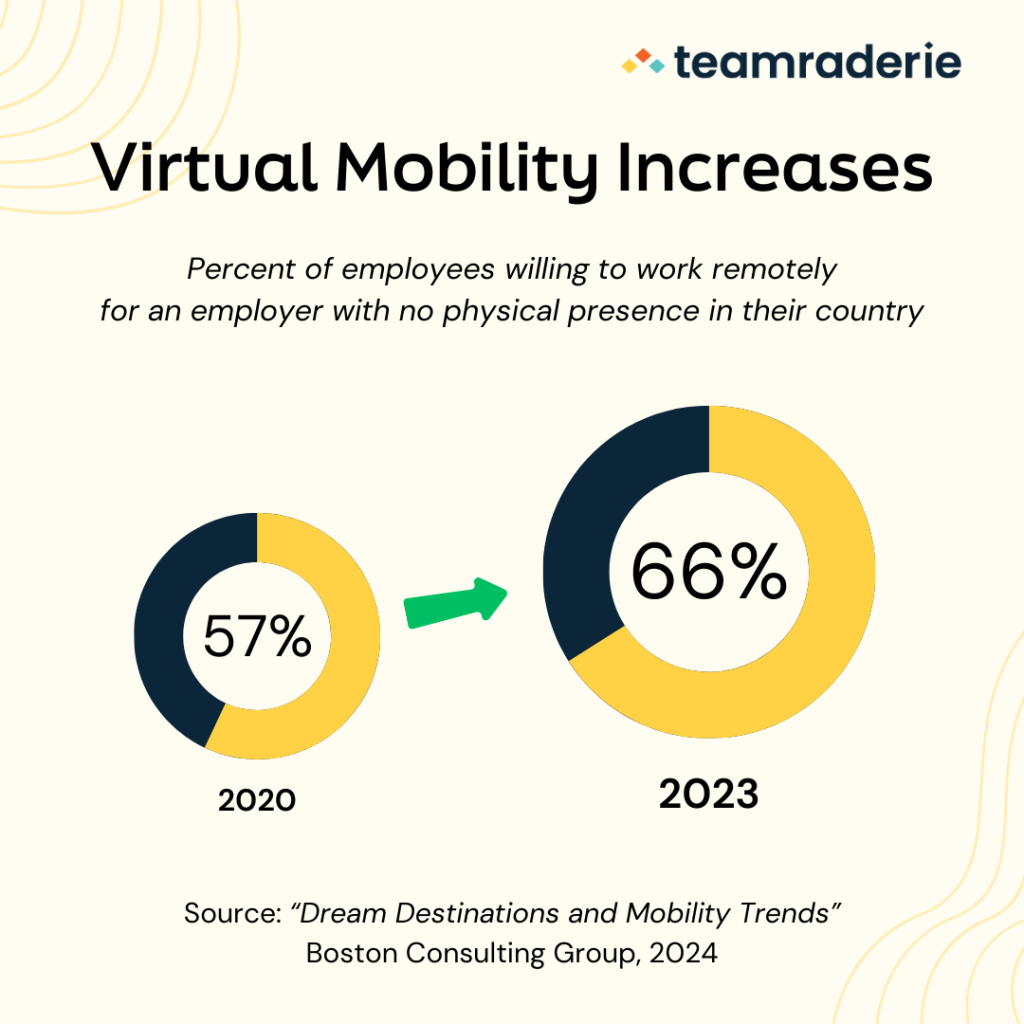The COVID-19 pandemic spiked a widespread increase in virtual work. Although many organizations have returned to office full-time, hybrid and remote arrangements are here to stay.
What does this mean for global teams, and how can leaders ensure that their teams remain connected over long distances?
Here are some of the top trends pertaining to virtual work and how they impact distributed teams.
What Is Virtual Mobility?
To understand some of the most impactful virtual team trends impacting modern workforces, it’s important to understand the concept of virtual mobility.
Virtual mobility is the ability to take on remote work, both within the country and internationally. For example, an employee can now easily work for an organization without any physical presence in the employee’s country.
This increase has corresponded to an increase in flexible work hours and other similar amenities for employees.
Some organizations operate without any physical presence at all.
Below are three virtual work trends impacting modern teams.
3 Trends in Virtual Mobility
Boston Consulting Group (BCG) conducted a study of over 150,000 people in 188 countries and uncovered big shifts in the map of global mobility:
1. Declined Interest in Moving Abroad for Work
Willingness to move abroad has declined by 15% since 2018.
The travel restrictions during the pandemic initially accelerated this decline. However, although travel restrictions have been lifted, the number of people willing to relocate internationally for work continues to decline.
A significant factor in this continued desire to remain local is likely the enhanced ability to work from home.

2. Changes in the Top 10 Work Destinations
Of those willing to relocate, the top destinations continue to shift.
The United States, which held the number one position for a long time was overtaken by Canada in 2020, and Australia in 2023.
This is largely because of the employment boom Australia experienced following the pandemic. With relatively high wages and high levels of demand for talent, Australia is an attractive destination for many prospective employees.
Furthermore, approximately 76% of people who moved to Australia for work had a positive experience. This is likely to continue drawing more people to the continent.

3. Increased Overall Interest in Virtual Mobility
Although fewer employees are willing to move to another country for work, an increasing number are willing to work for an international organization—provided they can stay home.
BCG reports that approximately 66% of respondents are willing to work remotely for an employer that doesn’t have a physical presence in their home country—up from 57% in 2020. This level is well above the proportion who are open to physical relocation.
These shifts create new opportunities and challenges for companies. Teams will likely become more geographically dispersed and global. Leaders need to prepare accordingly.
According to Dr. Tsedal Neeley, Professor of Business Administration at Harvard Business School, the main difference between global teams that work and those that don’t lies in the level of social distance—the degree of emotional connection among team members.
Mitigating social distance is the primary management challenge for a global leader.

Impact of Geographically Dispersed Teams
Living far away from a business used to make it impossible to work for them.
That’s no longer the case. Videoconferencing and other software make the process easier.
That isn’t to say that there aren’t disadvantages to having a geographically dispersed team. However, it’s important to consider both the pros and cons.
Advantages
The advantages of a global workforce can include the following:
- Access to a wider talent pool: You can find qualified team members anywhere in the world, without geographical limitations.
- Cost savings on relocation: Virtual team members eliminate the expense of relocating employees.
- Improved employee satisfaction: Offering flexibility and work-life balance through virtual employment can increase employee happiness.
- Enhanced productivity: Happy and satisfied virtual team members often demonstrate higher productivity.
- Extended business hours: Having a global team allows companies to operate across multiple time zones, providing extended service and support to customers.
With these advantages come potential drawbacks as well.
Disadvantages
Some of the most common disadvantages of virtual work can include the following:
- Maintaining a sense of belonging and inclusion: It can be difficult to foster a sense of community and engagement when team members are geographically dispersed.
- Addressing employee isolation: Remote workers may feel isolated, which can lead to decreased engagement and productivity.
- Impact on engagement rates: Lack of face-to-face interaction can negatively impact engagement levels.
- Distractions: Remote workers may face distractions at home, such as children, pets, or household tasks.
- Potential for miscommunication: Communication through direct messages or emails can lead to misunderstandings due to the absence of nonverbal cues and tone of voice.
The good news is that there’s an abundance of tools to help with these challenges.
Tips for Managing a Global Team
The truth is that global teams can work. The problem arises when leaders attempt to take in-person business models and transfer them directly to a remote environment.
It’s vital for leaders to remember that what works for an in-person organization won’t necessarily work for a remote team.
Furthermore, cultural and geographical differences must be considered and accommodated to create an inclusive environment for all employees.
Ultimately, you need to make sure that your employees are connecting with one another and collaborating effectively.
Although connection and flexibility are often perceived as tradeoffs, the reality is that distributed teams can feel connected despite the physical distance. Leaders must facilitate opportunities for their teams to connect.
Read more: 10 Ways For Remote and Distributed Teams to Stay Connected
Teamraderie’s live, virtual team experiences are perfect for this purpose. These 45-minute expert-led workshops are designed to help your team connect, upskill, and enhance inclusion.
Click here to explore our experience finder and find the perfect experience for your team.

